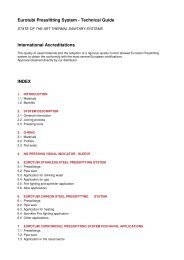corrosion of stainless steel - Damstahl
corrosion of stainless steel - Damstahl
corrosion of stainless steel - Damstahl
Create successful ePaper yourself
Turn your PDF publications into a flip-book with our unique Google optimized e-Paper software.
Chapter 6 - Corrosion <strong>of</strong> Stainless Steel<br />
Ferritic <strong>steel</strong> grades<br />
are stable in price<br />
Release <strong>of</strong><br />
nickel into food<br />
Mechanical<br />
strength <strong>of</strong><br />
nickel alloys<br />
Another benefit to using ferritic <strong>steel</strong> is its relatively low and very stable price<br />
which does not depend upon the high and volatile price <strong>of</strong> nickel (see Figure<br />
4.2 on page 43). The price <strong>of</strong> the ferritic <strong>steel</strong> is therefore much more stable<br />
than for the austenitic which naturally sparked a certain interest around<br />
2006 and 07. As the price <strong>of</strong> nickel subsequently fell sharply between 2008<br />
and 2009, interest fell correspondingly, but at the time <strong>of</strong> publication it is<br />
slowly on its way up again. This does not, however, change the fact that in<br />
the ferritic world there is a much poorer range <strong>of</strong> <strong>steel</strong> qualities and supply<br />
forms than for the austenites. Especially the stabilised, ferritic <strong>steel</strong> (e.g.<br />
4509 and 4521) are currently difficult to find in any other form but thin<br />
<strong>steel</strong> sheets (Section 9.1 on page 169).<br />
Apart from the price, the ferrites have the psychological advantage that the<br />
risk <strong>of</strong> release <strong>of</strong> nickel from nickel-free <strong>steel</strong> is zero which makes the ferritic<br />
<strong>steel</strong> particularly suitable for food-related applications. 4016 is especially<br />
popular for many catering applications both in the UK and Italy, and the<br />
weldable 4509 is used widely for both interiors and exteriors <strong>of</strong> refrigerators,<br />
cf. Figure 2.4 on page 18. For further information about food-grade <strong>stainless</strong><br />
<strong>steel</strong> please see Section 6.9.1.<br />
Note also that three nickel-based alloys have crept their way into Table 6.1:<br />
Inconel 600, Inconel 625 and Hastelloy C-276. Nickel alloys can be treated<br />
in parallel with the <strong>stainless</strong> <strong>steel</strong> when it comes to pitting <strong>corrosion</strong>, and<br />
increased resistance to <strong>corrosion</strong> is achieved, <strong>of</strong> course, by adding as much<br />
chromium and molybdenum to the <strong>steel</strong> as possible. Unfortunately, this<br />
needs to be balanced by an equivalent quantity <strong>of</strong> nickel (see Figure 3.2 on<br />
page 26), and at some point so much nickel will have been added that iron (Fe)<br />
simply becomes a minority constituent and we get a nickel alloy instead. It<br />
is therefore reasonable to regard the high <strong>corrosion</strong>-resistant nickel alloys<br />
as natural extensions <strong>of</strong> <strong>stainless</strong> <strong>steel</strong>.<br />
At the other end <strong>of</strong> Table 6.1 it is interesting that Inconel 600, despite at least<br />
72% Ni, falls way down the table. In the case <strong>of</strong> simple pitting <strong>corrosion</strong>,<br />
Inconel 600 simply performs poorer than standard 4301 which is because<br />
the alloy only contains 14% Cr. The 72% Ni do not help much in the creation<br />
<strong>of</strong> the passive layer, but there is nothing odd about that. Inconel 600 and<br />
its relative Inconel 601 (21-25 Cr, 58-63 Ni) were developed for their good<br />
mechanical strength at high temperatures and excellent resistance towards<br />
corrosive flue gases, but they are no good under oxidising conditions at<br />
room temperature. A bit like a Ferrari which is brilliant on a racetrack,<br />
but performs poorly on a bumpy gravel road. A 4WD Land Cruiser has<br />
the opposite strengths and weaknesses - and the same goes for metals. All<br />
alloys have their strengths and limitations, and the trick is always to find<br />
the combination <strong>of</strong> properties that best meet the needs <strong>of</strong> each individual<br />
project.<br />
99<br />
RS for alle.indb 99<br />
9/29/2011 12:44:39 PM

















